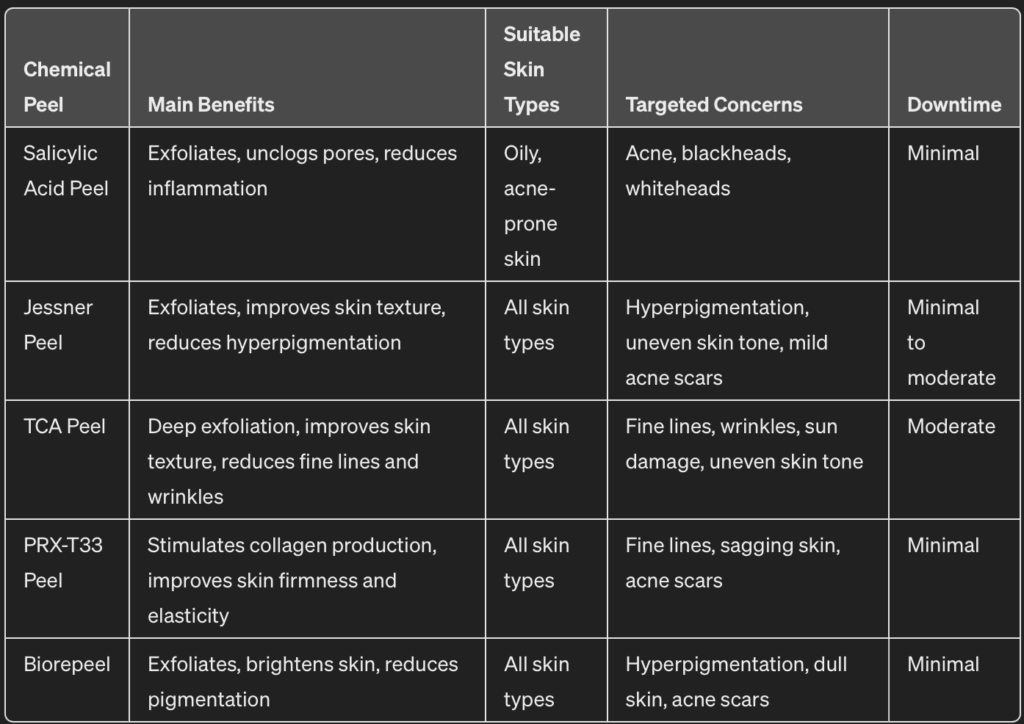- SHAH ALAM(HQ) | KOTA DAMANSARA | DATARAN JELATEK | BANGI | SEREMBAN
- +60173242801
- Klinikdrs@gmail.com
Chemical peel is a cosmetic procedure used to improve the appearance of the skin on the face, neck, or hands. It involves the application of a chemical solution to the skin, which causes it to exfoliate and eventually peel off. This process leads to the regeneration of new skin, revealing smoother, less wrinkled skin underneath. Chemical peels are commonly used to treat wrinkles, skin discoloration, acne scars, and sun damage
We offer variety of chemical peel rating from brightening glow peels, lifting peels, acne peels and melasma pigmentation peels such as salicylide acid, jessner, TCA, PRX and biorepeel chemical peels.

Chemical peels help in removing dead skin cells, promoting the growth of new skin cells, and improving skin texture.
By stimulating collagen production, chemical peels can reduce the appearance of wrinkles and fine lines.
Chemical peels can help in reducing hyperpigmentation, dark spots, and uneven skin tone, resulting in a more uniform complexion.
Chemical peels can unclog pores, reduce acne breakouts, and improve acne scars.
Chemical peels can rejuvenate dull-looking skin, leaving it looking brighter and more radiant.

A thorough consultation will be conducted to assess your skin concerns, determine the most suitable peel formulation, and discuss your treatment goals.

Preparation: Your skin will be cleansed to remove any makeup, oil, or debris.
Application: The chemical peel solution will be carefully applied to your skin, and you may experience a mild tingling or burning sensation.
Neutralization (if applicable): Depending on the type of peel used, the solution may be neutralized after a specific amount of time to stop the peeling process.

Post-Treatment Care: After the peel, your skin will be moisturized and sunscreen will be applied to protect your skin from sun exposure.
Skin Preparation: Cleanse and prep the skin.
Application of Chemical Solution: Apply the chemical peel solution.
Peeling Process: Allow the skin to peel and regenerate.
Monitoring and Neutralization: Monitor skin reaction and neutralize if needed.
Post-Peel Care: Apply soothing products and follow aftercare instructions.
A typical Chemical Peel treatment session can last anywhere from 60 to 90 minutes, depending on the specific procedures included and the complexity of your skin concerns.
Apply a hydrating moisturizer to keep the skin nourished and hydrated.
Protect your skin from sun exposure by wearing sunscreen daily, even on cloudy days.
Avoid using harsh skincare products or treatments immediately after the facial, as your skin may be more sensitive.
While chemical peels can benefit various skin types, it’s essential to consult with a skincare professional to determine the most suitable peel for your skin. People with certain skin conditions or sensitivities may require a customized approach.
Mild side effects such as redness, peeling, and temporary sensitivity are common after a chemical peel. However, serious complications are rare when the procedure is performed by a qualified professional. It’s crucial to follow post-peel care instructions to minimize any potential risks.
The number of sessions required depends on various factors, including the type of peel, skin condition, and desired outcomes. While some people may see noticeable improvements after a single session, a series of peels spaced several weeks apart is often recommended for optimal results.
The downtime following a chemical peel can vary depending on the type and depth of the peel. While lighter peels may result in minimal downtime with mild redness and peeling, deeper peels may require several days to a week of recovery time. It’s essential to plan accordingly and avoid sun exposure during the healing process.
The duration of results can vary depending on factors such as the type of peel, skincare regimen, and sun protection practices. Generally, the results of a chemical peel can last several months to a year, with maintenance treatments recommended to prolong the benefits over time.
